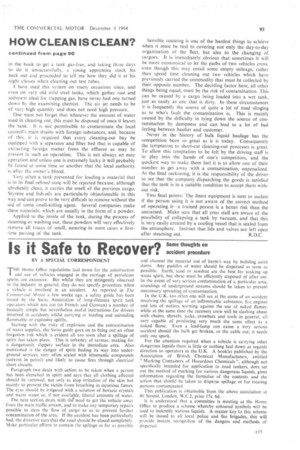Is it Safe to Recover? a S c o c m ul e en th t o p u ro gh ced b !i n n
Page 95

If you've noticed an error in this article please click here to report it so we can fix it.
BY A SPECIAL CORRESPONDENT
THE Home Office regulations laid down for the construction and use of vehicles engaged in the carriage of petroleum spirits are extensive. But whilst they are stringently observed in the industry in general, they do not specify procedure when a vehicle is involved in an accident. As reported in The Commercial Motor a few weeks ago, a safety guide has been issued by the Swiss Association of long-distance spirit tank operators which sets out (in French and German) a number of basically simple but nevertheless useful instructions for drivers involved in accidents whilst carrying or loading and unloading flammable or explosive spirits.
Starting with the risks of explosion and the contamination of water supplies. the Swiss guide goes on to bring out an often forgotten risk which is evident all too soon after a spillage of spirit has taken. place. This is solvency of tarmac, making for a dangerously slippery surface in the immediate area. Also mentioned is the danger of spirit finding its way into underground services, very often sealed with bitumastic compounds (solvent in petrol) and likely to cause fires through electrical short circuits.
Paragraph two deals with action to be taken when a person has been drenched in spirit and says that all clothing affected should be removed, not only to stop irritation of the skin but mainly to prevent the victim from breathing in injurious fumes. The eyes should be irrigated with a solution of boraeic crystals and warm water or, if not available, liberal amounts of water.
The next section deals with the' need to get the vehicle away from the main traffic stream, and to make any temporary repairs possible to stem the flow of cargo so as to prevent further contamination of the area. If the accident has been particularly bad, the directive says that the road should be closed completely. Make particular efforts to contain the spillage as far as possible and channel the material out of harm's way by building earth dams. Any puddles of water should be dispersed as soon as possible. Earth, sand or sawdust are the best for soaking up waste spirit, but these must be efficiently disposed of after use. In the event of very serious contamination of a particular area, soundings of underground streams should be taken to prevent unecessary spreading of contamination.
In the U.K. too often one will see at the scene of an accident involving the spillage of an inflammable substance, fire engines and lots of notices warning against the use of naked flames, while at the same time the recovery crew will be slashing about with chains, shovels, jacks, crowbars and tools in general, all very capable of producing very much the same effect as a naked flame. Even a lead-lamp can cause a very serious accident should the bulb get broken, or the cable cut; it needs only one spark.
For the attention required when a vehicle is carrying other dangerous liquids there is little or nothing laid down as regards direction to operators in the U.K. A booklet published by the Association of British Chemical Manufacturers, entitled "Marking Containers of Hazardous Chemicals ", although not specifically intended for application to road tankers, does set out the method of marking for various dangerous liquids, gives information regarding the formulae of the contents and the action that should be taken to disperse spillage or for treating persons contaminated.
This publication is obtainable from the above association at 86 Strand, London, W.C.2, price 17s. 6d,
It is understood that a committee is meeting at the Home Office to produce a scheme whereby coloured symbols will be used to indentify various liquids. A master key to this scheme will be issued to all local police and fire brigades, this will provide instant recognition of the dangers and methods of dispersal.
































































































































































































